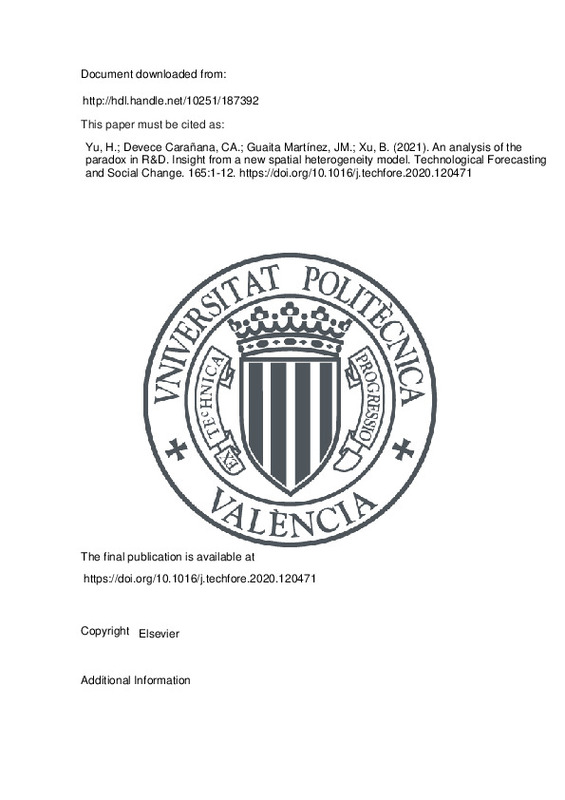JavaScript is disabled for your browser. Some features of this site may not work without it.
Buscar en RiuNet
Listar
Mi cuenta
Estadísticas
Ayuda RiuNet
Admin. UPV
An analysis of the paradox in R&D. Insight from a new spatial heterogeneity model
Mostrar el registro sencillo del ítem
Ficheros en el ítem
| dc.contributor.author | Yu, Haijing
|
es_ES |
| dc.contributor.author | Devece Carañana, Carlos Alberto
|
es_ES |
| dc.contributor.author | Guaita Martínez, José Manuel
|
es_ES |
| dc.contributor.author | Xu, Bing
|
es_ES |
| dc.date.accessioned | 2022-10-10T18:07:51Z | |
| dc.date.available | 2022-10-10T18:07:51Z | |
| dc.date.issued | 2021-04 | es_ES |
| dc.identifier.issn | 0040-1625 | es_ES |
| dc.identifier.uri | http://hdl.handle.net/10251/187392 | |
| dc.description.abstract | [EN] The relationship between research and development (R&D) and economic growth is a hot topic. Most research indicates that R&D leads to innovation, which is conducive to economic growth. However, some scholars hold a different opinion, alleging that high R&D investment will not bring high economic growth. This scenario is also known as the Swedish paradox. We develop a new spatial heterogeneity model in the form of a mixed geographically weighted panel regression with spatial Durbin model (MGWPR-SDM). Using this model, we add to the debate over the possible existence of a Swedish paradox in China. The results show that the impact of aggregate R&D expenditure on economic growth follows an inverted U-shaped curve. The Swedish paradox appears after a threshold is reached, mainly due to business enterprise R&D expenditure rather than government R&D investment. However, from the perspective of R&D input per unit GDP, the impact of R&D intensity on economic growth is U-shaped, and the Swedish paradox occurs before the threshold is reached. Finally, the effect of government R&D expenditure and business enterprise R&D expenditure on economic growth has significant spatial heterogeneity. | es_ES |
| dc.description.sponsorship | The authors are very grateful to anonymous reviewers for their valuable comments that improved the quality of this paper. This work is supported by the Outstanding Youth Program of Zhejiang Natural Science Foundation under Grant LR20G030001; Key projects of Statistical Science Research of Zhejiang Provincial Bureau of Statistics Grant TJZZ03; and First Class Discipline of Zhejiang -A (Zhejiang Gongshang University-Statistics). | es_ES |
| dc.language | Inglés | es_ES |
| dc.publisher | Elsevier | es_ES |
| dc.relation.ispartof | Technological Forecasting and Social Change | es_ES |
| dc.rights | Reconocimiento - No comercial - Sin obra derivada (by-nc-nd) | es_ES |
| dc.subject | R&D | es_ES |
| dc.subject | Swedish paradox | es_ES |
| dc.subject | Economic growth | es_ES |
| dc.subject | Spatial heterogeneity | es_ES |
| dc.subject | MGWPR-SDM | es_ES |
| dc.subject.classification | ECONOMIA APLICADA | es_ES |
| dc.subject.classification | ORGANIZACION DE EMPRESAS | es_ES |
| dc.title | An analysis of the paradox in R&D. Insight from a new spatial heterogeneity model | es_ES |
| dc.type | Artículo | es_ES |
| dc.identifier.doi | 10.1016/j.techfore.2020.120471 | es_ES |
| dc.rights.accessRights | Abierto | es_ES |
| dc.contributor.affiliation | Universitat Politècnica de València. Departamento de Organización de Empresas - Departament d'Organització d'Empreses | es_ES |
| dc.contributor.affiliation | Universitat Politècnica de València. Departamento de Economía y Ciencias Sociales - Departament d'Economia i Ciències Socials | es_ES |
| dc.description.bibliographicCitation | Yu, H.; Devece Carañana, CA.; Guaita Martínez, JM.; Xu, B. (2021). An analysis of the paradox in R&D. Insight from a new spatial heterogeneity model. Technological Forecasting and Social Change. 165:1-12. https://doi.org/10.1016/j.techfore.2020.120471 | es_ES |
| dc.description.accrualMethod | S | es_ES |
| dc.relation.publisherversion | https://doi.org/10.1016/j.techfore.2020.120471 | es_ES |
| dc.description.upvformatpinicio | 1 | es_ES |
| dc.description.upvformatpfin | 12 | es_ES |
| dc.type.version | info:eu-repo/semantics/publishedVersion | es_ES |
| dc.description.volume | 165 | es_ES |
| dc.relation.pasarela | S\424741 | es_ES |
| dc.subject.ods | 08.- Fomentar el crecimiento económico sostenido, inclusivo y sostenible, el empleo pleno y productivo, y el trabajo decente para todos | es_ES |







![[Cerrado]](/themes/UPV/images/candado.png)

